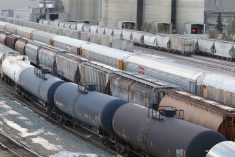Glacier FarmMedia – Canada narrowly averted a transportation disaster in August. Now legal experts are digesting the repercussions of the recent labour dispute at the nation’s two major railways.
When the conflict between the Teamsters Canada Rail Conference union and both Canadian Pacific Kansas City and Canadian National Railway came to a head Aug. 22, trains were fully stopped for less than 24 hours.
Related stories: WP rail labour dispute coverage
Read Also

Canada’s plant hardiness zones receive update
The latest update to Canada’s plant hardiness zones and plant hardiness maps was released this summer.
After the federal government referred the matter to the Canada Industrial Relations Board for binding arbitration, employees at CN were back at work Aug. 23. The stoppage at CPKC lingered longer, but trains were all running within four days of the initial lockouts and strike action.
Experts say recovery will take more time than the stoppage lasted.
“It takes a long time to make up for that lost time,” said Mark Hemmes, president of Quorum Corporation, which monitors Canada’s grain shipping industry.
“And while the lockout was only four days, you really have to think about it in terms of 10 to 12 days because of the embargoes that were put on the railways as they positioned themselves for an orderly shutdown.”
Railways limited shipment of volatile materials, including some fertilizer, in anticipation of the stoppage.
Hemmes noted that cars loaded at Canada’s ports will have been unloaded and left on tracks. It will take time for the railways to move those cars back into position.
“We like to refer to it as the bathtub effect,” he said. “If you take water in a big tub and you keep tilting it back and forth, you end up with big waves at one end or the other and it takes a while for that to settle out.”
The situation will force railways to prioritize shipments, starting with perishable goods, chlorine for municipalities and animal feed. From there, they’ll work on the backlog of more competitive commodities.
“That has a tendency to be the intermodal stuff,” said Hemmes. “The container ports at Vancouver and Montreal will get a lot of attention first, because they’ve got to clear out the container terminals, which are probably pretty full at this point because the boats kept coming but there was nothing taking stuff away.”
Grain tends to fall farther down the priority list. Hemmes expects that agriculture won’t return to normal for six weeks, at best.
“I think we’re going to have to wait until October before we see something resembling normal rail service.”
Wade Sobkowich, executive director of the Western Grain Elevator Association, said farmers won’t be unscathed. Timing of the dispute was unfortunate because harvest had just begun when the labour issue picked up steam.
“We never have excess rail capacity at this time of year. So, you never truly recover until you get yourself into a period of lower volumes, when things drop off in the spring and summer,” Sobkowich said.
Grain companies will have deferred sales due to uncertainty about service suspension, he added.
“So now you’re selling more grain outside that peak period before the Australian harvest, so you’re going to get less value for some of the crop due to this stoppage.”
The rail halt didn’t last long enough to significantly disrupt the grain elevator system. Sobkowich said he’s fairly certain elevators will be able to handle 2024 harvest volumes.
“We weren’t right in the thick of harvest quite yet. I think there’s room in the country elevator system, so farmers can deliver to most, if not all, locations.”
When rail employees voted to strike earlier this year, Sobkowich expressed concern that a stoppage would damage Canada’s status as a reliable trade partner. That concern still stands.
“There will be reputational damage, and how long that damage is going to last will depend on what we do from here,” he said. “Are we going to be able to make it through the rest of the year, or the next three or the next five years, without any disruptions? You have to earn that reputation back.”
Bruce Curran, a University of Manitoba law professor who specializes in labour law, said that even though the teamsters union plans to challenge the back-to-work ruling, disruption is unlikely for at least another year.
The binding arbitration decision that sets terms of the bargaining agreement will happen in coming weeks. Curran suggested the judicial review sought by the union will not come to court for about six months. Even if the court finds that the back-to-work decision was a mistake, it is unlikely the collective agreement arising from arbitration would be torn up.
“That will remain in place for the duration of their collective agreement, which will probably be about three years or so,” he said.
A simultaneous negotiation of collective bargaining agreements for both railways is unlikely to occur again, Curran added.
“These collective agreements have not been synced in over 70 years. I think that the arbitrator will also be clear that they’re not going to be synced in the future, so as not to lead us into the same position that we’re in here.”
He thinks the situation devolved due to a strategic blunder. In 2020, the federal government announced new regulations on safety and fatigue management for railways, with a scheduled implementation from 2022 to 2024.
CN’s collective agreement was scheduled to be negotiated in 2022, but it arranged to start negotiations a year later to address the new rules. That delay aligned it with CPKC’s negotiations.
“This gave the Teamsters a tremendous increase in their bargaining power because they had the ability to shut down the entire country at the same time,” Curran said.
To avoid a repeat, the standard three-year collective agreement with CN and its employees will likely revert to three years from 2022, when their agreement was originally going to expire. CPKC’s collective agreement may run three years from December 2023 to 2026, he suggested.
That would mean another labour dispute wouldn’t potentially arise until late 2025 or early 2026.
On Aug. 30, the Teamsters Canada Rail Conference union said it would take the Canada Industrial Relations Board to court over the binding arbitration and back-to-work orders.
















